Some time ago, a patient came to my office for an audiometric evaluation. When I checked his ears, I noticed a burnt-ash smell (sort of like a chimney) from several inches away. Both ears were impacted with cerumen and debris per otoscopic inspection. He had just come from an ear candling session.
Patients sometimes ask, "How do I remove wax from my ears? Have you ever heard of ear candles? Does it work?" Of course, we need to give truthful and correct answers. The answer is simple: There is no proof ear candles do anything besides pose a dangerous risk for significant damage.
In this brief news article, we'll explore a little bit of the outrageous claims and expectations consumers are exposed to regarding ear candles.
Background:
A wealth of information is a mouse-click away on the Internet, whether it's true or not! Here are some quotes from actual websites, based on a simple Internet search for ear candles performed in July, 2005. Please note the questions and answers are essentially unchanged from the websites that published them, and please note that each answer contains grossly erroneous information and misleading statements.
Q: What kind of results can I expect (from ear candling):
A: Results vary with the individual. Most people have a much greater problem with wax and moisture in their ears than they realize. Wax and moisture can also affect the functioning of the inner ear, which is critical to our sense of balance.
Q: What happens if wax drips into my ears?
A: Dripping wax may feel warm, but if it is beeswax, it should not be hot enough to do any damage. Many people soak inflamed areas of their bodies in melted beeswax. Just use another Ear Candle to pull it out.
Q: Does the residue of the candle go into the ear?
A: No - the candles are made with a plug inside which prevents anything going into the ear.
Q: Does it help to have a treatment before taking a flight?
A: Yes - if you have no ear infection and if you suffer with ears or sinus problems, it is a good idea to have a treatment prior to your flight to get rid of any excess wax."
Availability of Ear Candles:
I purchased 100% beeswax ear candles in a local health food store. The back of the box stated, "Used for centuries, ear candles aid the ears in their own natural cleansing ability." The back of the box states, "This product has not been tested by the FDA, and makes no claims to diagnose, treat, cure, or prevent any disease." However, a paper insert with instructions in four languages offered:
It (ear candling) is an all-natural process used to sooth the ears and to help relieve pain and itching from infections and other conditions. The process helps soften old, hardened earwax and assists the body to excrete excess earwax. Other benefits may include helping dry out fluids in the ear canal.....ear candles have been used by millions of people worldwide, with positive results.The insert also said:
Note: This product is not to be used as a treatment or cure for any disease, condition, or ailment. The user assumes full responsibility and shall not hold either the manufacturer or seller liable for any claims, obligations, injury, expense, or damage arising from its use.
 Brief Experiment:
Brief Experiment:In the Skeptical Inquirer, DeMeo described two simple tests which proved that ear wax was not removed from the ears via ear candling:
Two simple tests can be performed to show that no earwax is indeed removed by the candling procedure. First, acquire a small clean test tube (to simulate the narrow ear canal) and into it add a weighed piece of wax, preferably human earwax. Heat the test tube containing the wax to body temperature in a hot water bath. Next, fit the candle into the test tube and then ignite the top of the candle with a match. After about half the candle has burned, extinguish the flame. When one examines the test tube containing the human earwax during the burning process, it will be observed that the earwax does not change in any way; it neither travels up the test tube nor does it enter the candle.
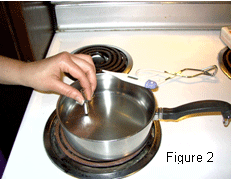
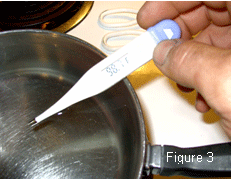
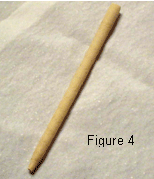
The mass of the human earwax before and after candling is the same. Furthermore, when one opens up the bottom tip of the partially burned candle, the dried solid is observed to be in a quantity greater than the earwax placed in the test tube. This simulation strongly suggests that none of the human earwax is being removed by the candling process, but instead, the extracted substance originates from the candle itself. A second test supports these findings. When the above procedure is repeated but without any human earwax in the test tube, the same result occurs - a yellow dried solid is found inside the bottom tip of the candle."

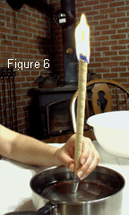
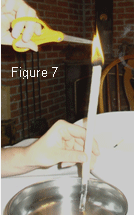
We (Shenk and Dancer) followed the above procedure. Several 75 mm testubes were obtained. According to our gram scale, 0.09g of human ear wax was obtained (figure 1) and placed into one of the test tubes. The test tube was inserted into a pan of water and heated to approximate body temperature (figures 2 and 3). A 100% beeswax ear candle (figure 4) was inserted into the tip of the test tube and the other end was ignited (figures 5 and 6). According to instructions, the candle was trimmed every four inches (figure 7) and the ashes extinguished in a bowl of water (figure 8). When the candle was approximately four inches long, it was removed from the test tube and extinguished as well (figure 9). The cerumen and debris in the test tube (figure 10) was removed and weighed (figure 11). The tip of the candle (figure 12) was cut open and the contents observed (figure 13).

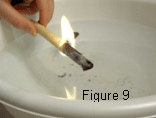
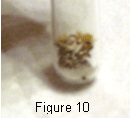
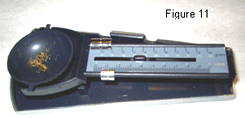
In our second experiment, an ear candle was inserted into the end of an empty 75 mm test tube (figure 14). According to manufacturer's instructions, it was trimmed every four inches and extinguished when only four inches were left (figures 15 and 16). When the candle was cooled, the tip of the candle (figure 17) was cut open and the contents observed (figure 18).
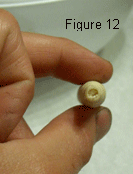
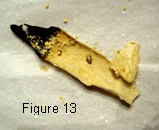
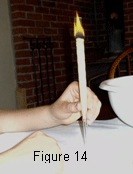
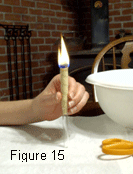
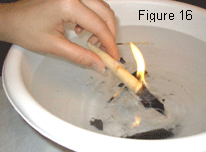
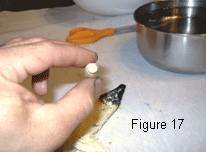
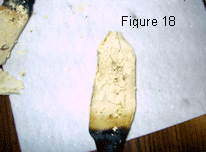
Results:
Visually, both test tubes appeared to have a waxy build up in them after the candle was burned. The mass of the wax, which was 0.09g prior to the candle being burned, was 0.13g after the candle was burned. When the candles were cut open, both appeared to have a brownish-gold build up near the tip. There was no difference in the appearance of the one that was burned with the wax in the test tube or the one burned with the empty test tube. No wax was removed from the test tube by the ear candle. In fact, the wax gained mass due to exposure to the burning candle. They are not an effective method of removing cerumen from the ears.
Conclusion:
The purpose of this brief article was to offer professionals a look into what various consumer-based publications say about ear candling.
From a professional standpoint, it sounds absolutely ridiculous. To consumers, however, some of it sounds like the answer they've been searching for. Audiologists and other hearing health care providers are best able to help consumers and patients if we're aware of what they've been exposed to. There are literally dozens and dozens of websites, health-food stores and pseudo-science books dedicated to ear candling. Consumers should be wary of the claims made regarding ear candles.
Reference:
DeMeo, S. (1998). The pseudoscience of wax removal. The Skeptical Inquirer. Available at: articles.findarticles.com/p/articles/mi_m2843/is_n6_v22/ai_21275518

